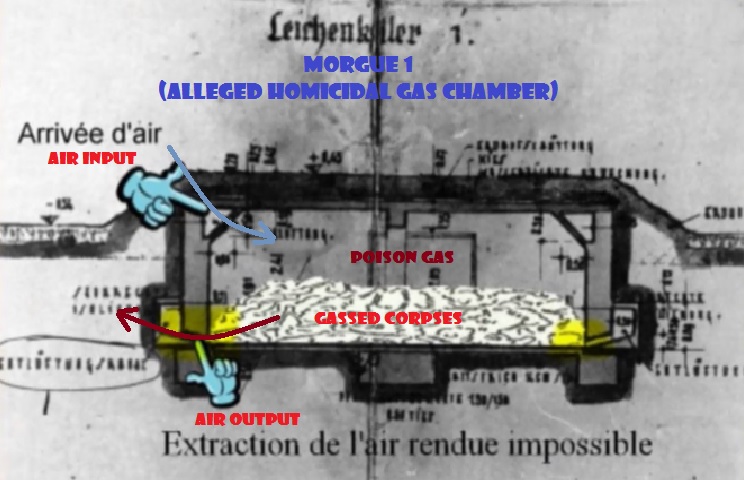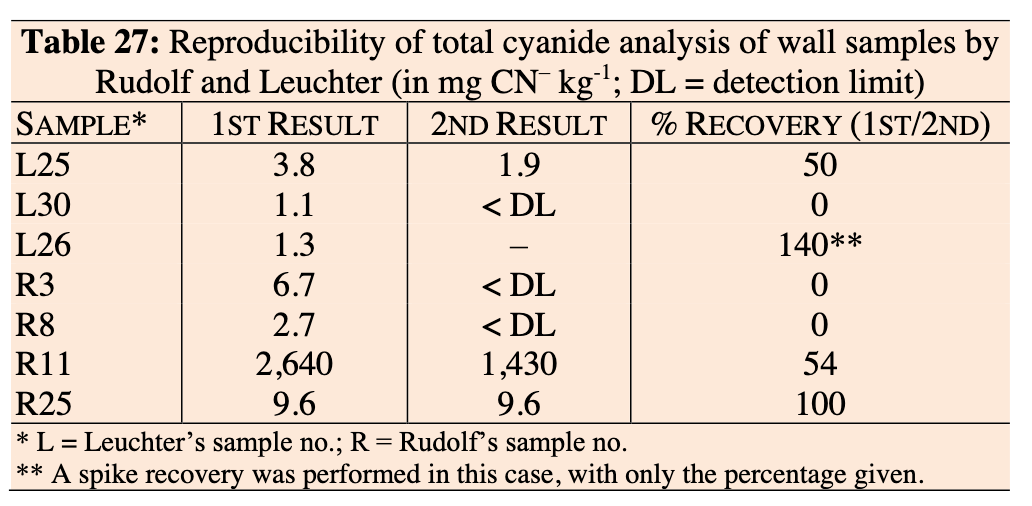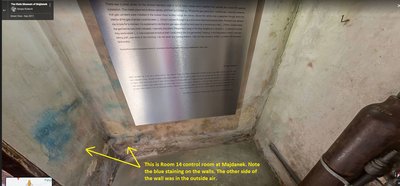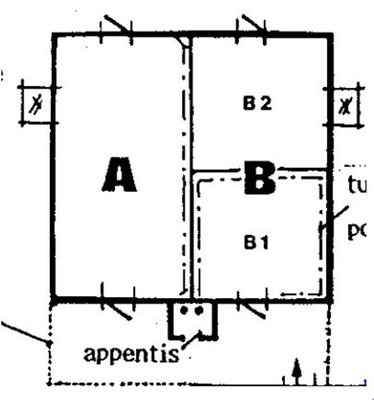We know Hydrogen Cyanide (HCN) is very reactive and has produced Prussian blue staining with just one single delousing. In The Rudolf Report, an example is provided of huge blue stains covering the interior walls of an old church after being fumigated only once with Zyklon B in the 1970s (see: http://www.vho.org/GB/Books/trr/1.html#1.3.)
So it doesn't necessarily take long-term, repeated exposure to HCN to bond with iron in building materials when the conditions allow it.
From exterminationist "Historian" van Pelt's book on Auschwitz:
- Robert Jan van Pelt & Debórah Dwork (2002) 'Auschwitz: 1270 to the Present', pp. 219, 222"Zykon B had been introduced in Auschwitz in July 1940, when it was used to fumigate the Polish barracks which, according to Hoess, 'teemed with lice, fleas, and other bugs.' [...]
A violent typhus epidemic erupted in Auschwitz-Birkenau in the summer of 1942, and the whole lice-infested camp-barracks, offices, and workshops-had to be fumigated with tons of Zyklon B."
These fumigations of random parts of the camp are corroborated by an order issued on Aug. 12, 1942, by Camp Commandant Höß regarding accidents during the fumigation of barracks. From pg 201 of Pressac's book:
Code: Select all
Auschwitz Concentration Camp Auschwitz 12th August 1942
Kommandantur
Special Order
A case of indisposition with slight symptoms of poisoning by hydrocyanic gas which occured today makes it necessary to warn all those participating in the gassings and all other SS members, that in particular on opening rooms used for gassing, SS not wearing masks must wait at least five hours and keep at a distance of at least 15 meters from the chamber. In addition, particular attention should he paid to the wind direction.
The gas being used at present contains less odorous warning agent and is therefore especially dangerous.
The SS garrison doctor declines all responsibility for any accident that should occur in the case where these directives have not been complied with by SS members.
Signed: Höß
SS Lieutenant Colonel and Commandant The 1 September 1942 diary entry of Auschwitz Dr. Johann Kremer contains the following entry:
https://archive.is/W5CU8#selection-371.72-371.144"In the afternoon attended the fumigation of a barracks with Zyklon B against lice."
[Nachmittags bei der Vergasung eines Blocks mit Zyklon B gegen die Läuse.]
A circular from Dr. Mrugowsky from the SS Hygiene Institute, dated 13 May 1943, reads as follows:
"In the future therefore, cyanide gas can only be used for the fumigation of barracks in the concentration camps."
[In Zukunft darf daher Blausäure nur noch zur Vergasung von Baracken in Konzentrationlägern verwendet werden.]
The levels of cyanide found in the alleged homicidal gas chambers are not significantly different from random samples taken in inmate barracks. Germar Rudolf:
The Rudolf Report, 8. Evaluation of Chemical Analyses http://www.vho.org/GB/Books/trr/8.html#8.3.3.2."Quantities of cyanide on the order of magnitude of those found by Leuchter in the alleged 'gas chambers' can apparently also be found in the wall material of the inmate barracks. This is indicated by the results of Sample 8. All others are also positive, but notably lower. In this case as well, the control analysis (Table 20, p. 258) failed to yield reproducible results."
It is also possible that morgue 1 served as a temporary fumigation chamber early 1943, when several normal disinfestation facilities suffered from a fire and were out of service:
Die Leichenkeller der Krematorien von Birkenau im Lichte der Dokumente (The morgues of the Crematoria in Birkenau in the Light of the Documents)
»Bischoff wrote on January 9 1943 a letter to Kammler about the "Hygienic Installations in the K.L. and K.G.L. Auschwitz" listing all desinfestation- and delousing installations available. There were five in KL Auschwitz and four in KGL Birkenau.[26]
However during the following days failed due to fires the hot air apparatus designed by Topf in Block 1 of the main camp, the hot air apparatus fabricated by Hochheim in the desinfestation barracks for men and women, i.e. the delousing barracks BW 5a and 5b, and finally the hot air delousing equipment for the "army desinfestation installation".[27]
[26] RGVA, 502-1-332, S. 46-46a
[27] Bischoff-Brief »an den Kommandanten des KL Auschwitz - SS-Obersturmbannführer Höß« vom 18. Januar 1943. RGVA, 502-1-28, S. 256-258.
http://vho.org/VffG/2003/3/Mattogno357-365.html
If the alleged "Homicidal gas chambers" were exposed to as much Zyklon-B as claimed by the standard 'Holocaust' narrative, we would expect comparable levels of ferrocyanide residue when contrasted with the delousing chambers:

"In the following table I have listed the factors affecting the formation of Prussian Blue both for an interior wall of the delousing chamber of building 5a in Birkenau (left), and of the alleged homicidal gas chamber of Krematorium II in Birkenau (right). The first data row gives the actual result of the analyses for total cyanide of samples taken from these walls. The right column shows approximate factors linking both premises' tendency to form Prussian Blue. The resulting factor in fact indicates that similar amounts of Prussian Blue should be expected in both locations." - Germar Rudolf http://www.vho.org/GB/c/GR/CharacterAssassins.html
In conclusion, the levels of cyanide detected in samples of the alleged "Homicidal gas chambers" is consistent with occasional fumigations taken during a typhus epidemic ravaging the camp, but inconsistent with claims of mass murder of prisoners via Zyklon-B gassings.











